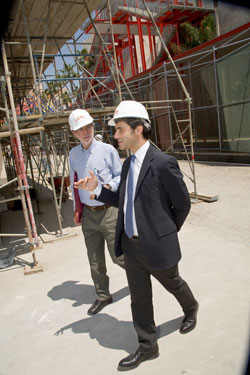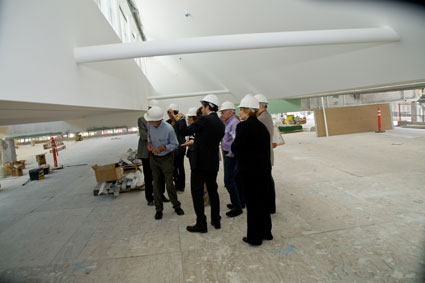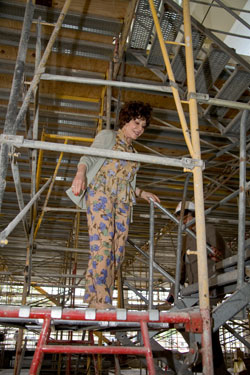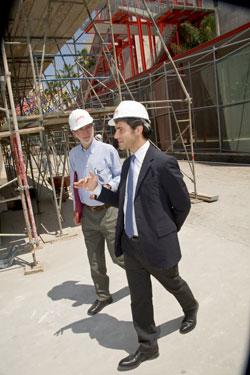One of the more interesting parts of my job as a communications specialist for LACMA is the behind-the-scenes access I have to various projects as they emerge on campus. Case in point: I recently walked through the construction site of the museum’s Resnick Exhibition Pavilion with an august group including the building’s donors, Mr. and Mrs. Stewart Resnick, the architectural team, Renzo Piano and Antoine Chaaya, and LACMA’s Director, Michael Govan.

Renzo Piano and Michael Govan
As fascinating as being able to tour an as-of-yet unfinished space was, it was even more enlightening to experience it through each person’s varied perspective.
One of the most notable aspects of the building is that its entire ceiling is made from saw-tooth glass, so the natural light flooding the space was on everyone’s mind. The ambient light created in the 45,000 square-foot area is warm and soft, and to this woman of a certain age, very kind.

In the Pavilion
Antoine described how the roof would reflect and diffuse the incoming southern light; he and Renzo also explained how the nylon mesh blinds are controlled by computerized timers that can be adjusted to address the needs of any exhibition, allowing for many variations of light—including its complete absence.

Lynda Resnick
Mrs. Resnick loved the lighting, too. She and her curator, Bernard Jazzar, who also joined the tour, discussed how dramatic the opening exhibitions would be in that space (more on those to come in future posts). There was talk of possible intimate candlelit dinners as well as the gala opening.
Renzo’s focus was also on the marble, which comes from the same quarry as that used in LACMA’s building for contemporary art, BCAM. Some of the differences between the buildings are that the Resnick Pavilion’s marble has been washed to looked aged; the public enters on the southern axis of the building; and there will be restrooms on the east and west quadrants as one enters featuring, in the words of the architect, some of “the most gorgeous toilets in the world.”
Michael saw the space from a curatorial vantage as a perfect square with vast convertible space, no wasted space, lots of light, and endless wall possibilities. He called it an “honest building.”
All in all, it was unusually fascinating for me, providing not only an enhanced perspective on the coming building but a heightened sense of excitement.
Barbara Pflaumer, Associate Vice-President of Communications



